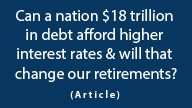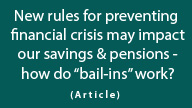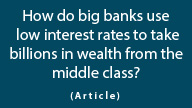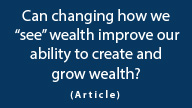Gas For $1.75 A Gallon & Depression Level Unemployment: The USA After A Euro Collapse
By Daniel R. Amerman, CFA
Overview
The US dollar could soar in value. Gasoline could return to under $2 a gallon, possibly even $1.75, and filling up a near empty tank could once again be done for under $30. The prices of clothes, shoes and a shopping trip to Wal-Mart could drop significantly, providing much needed relief to retirees on fixed-incomes. In the midst of global economic crisis, there could be an "Indian Summer" in the United States with a return to cheap oil and abundant imports at prices well below current levels. Standards of living could briefly rise - for those fortunate people who still have jobs and/or stable incomes.
As pleasant as it could be for some, this potential "Indian Summer" won't change the bigger picture. If the Euro collapses (and that's a big if), the end destination will likely be disastrous for the US economy, US employment and the value of the US dollar. For a US economy that is already reeling - the fall of the Euro and a corresponding implosion of European economies could take a bad situation and make it much, much worse. The brunt of this damage will be borne by the many millions of newly unemployed as well as retirees and investors, but many more will bear the pain.
However, the journey from a full Euro meltdown to the end results for the United States may take longer than many expect, and the particulars of the path could also take many by surprise. In this article, we will speculatively explore some of the potential twists and turns between Euro collapse and US economic disaster, and the economic logic that may drive them.
Starting Assumption: Euro Collapse & European Depression
Our starting assumption is the there is not only a collapse of the euro, but that this has a severe impact on Europe, pushing it into a continent-wide depression which slashes economic consumption as well as output. There are currently many opinions being offered in the financial media about why this may or may not happen, and we will leave it to those numerous articles to discuss the cases for and against a collapse.
Our objective herein is to do something quite different, which is to explore some of the surprising potential near and medium term effects of a European currency collapse on the lives of ordinary citizens in the United States, with the understanding that some of these effects may also hold true for other nations, such as Australia and Canada. This analysis complements my recent article, "Potential Euro Collapse & Rapid Redistribution Of Personal Wealth" (link below), which covers the particularly sharp redistribution of wealth that would occur within Europe itself.
http://danielamerman.com/articles/2011/EuroFallC.html
We will assume that a basket of national currencies reappear, such as new French francs and new German deutsche marks. However, these types of transitions generally don't occur smoothly, in part because many people - including the citizens of those nations - will be reluctant to place too much trust in these brand new currencies, even as they likely reappear under old names. In the immediate aftermath of currency collapse, trust can be difficult to regain, so we will assume that purchasing power is way down in Europe, and that around the world, the reborn national currencies are not yet trusted.
Please note that the scenario covered herein is intended as an exploration rather than a precise forecast. There are many factors in play and many possible paths, with one path being a successful defense of the euro.
The US Dollar Rules The World, Again
The persistent strength of the US dollar is a source of puzzlement to many contrarian investors. This puzzlement is understandable as the United States is effectively a bankrupt nation in many ways, which can't even produce enough to support what it consumes, but instead relies on a massive trade deficit to bring in the goods that it needs. Ongoing current government deficits are currently running at the extraordinary level of about 10% of the national economy, and the situation will only be getting worse with tens of trillions of dollars of looming entitlement shortfalls. Making matters worse, the Federal Reserve has resorted to creating trillions of dollars out of thin air, in a blatant monetization of the kind which historically almost always ends badly.
All of the above notwithstanding – the dollar remains the world's reserve currency. The dollar thrived even in the midst of the adverse economic effects and the initial rounds of monetary creation in the financial crisis of 2008, and it wasn't even particularly damaged during the budget debacle in the summer of 2011 that could have potentially led to the US defaulting on its debts. Despite all of this the US dollar remains strong – because there is no substitute.
The Federal Reserve worked hard to lower the value of the dollar internationally, particularly in the fall of 2010, and was somewhat successful. Yet the dollar remains highly popular as the refuge currency of choice. Even with virtually no yields available with short term Treasuries, along with historically low yields with medium to long term Treasuries - and no credible solution in sight for the US national debt crisis - there still seems to be no shortage of foreign investors seeking to park their excess funds in US dollars.
Now let's consider what happens if the one former major competitor to the dollar as reserve currency – the euro – were to effectively implode. This could instantly and powerfully enhance the position of the dollar as the world's sole remaining reserve currency, and the short term effects might be a flood of foreign funds being sent into US dollar-denominated investments in general, and US Treasuries in particular. This could involve not only the rapid pulling out of funds from Europe, but many other investors may reduce exposures to their own currencies and make a move to the dollar as well, in an unprecedented flight to perceived safety.
After all, academic theories notwithstanding, the behavior of markets have never been coldly rational, but are instead driven by a pervasive and changing belief system. In a time of crisis - and this will be an unparalleled global currency crisis - the natural human reaction is to run where everyone else is running, for a perceived refuge to survive the storm.
Because we are talking about human belief systems - and not engineering - perceptions in markets do in fact create market reality, at least in the short term. The perception of the dollar as safe refuge may create the temporary reality of the dollar as peerless safe refuge - however illogical that may seem, when one considers that the US is arguably in at least as bad of shape as Europe, and will obviously end up being devastated by the events in Europe.
Many people believe that a strong dollar is good for the United States. There is some truth to that, because a strong dollar means that we pay less for what we import from other nations, and this is particularly true when it comes to energy and the massive amounts of oil which the US must import in order to maintain its energy-based economy. When the dollar is "strong", then that oil consumption is to some extent effectively being subsidized by the rest of the world, through maintaining the status of the US as the reserve currency.
However, there is a major downside to this extraordinary flood of cash from around the world into the US dollar - a downside so significant that it could be argued that the reason that the US dollar is the world's reserve currency is that nobody else is shortsighted enough to want that position. The Chinese do everything in their power to avoid having a strong currency, and Japan has spent decades trying to keep the yen weak.
The problem with a strong currency is that a nation's exports become very expensive for the rest of the world, while imports from other nations become remarkably inexpensive. Indeed, much of the hollowing out of the US economy that has occurred over the last 15 years is arguably the direct result of the strong US dollar. Because the value of the dollar is high - US workers have not been able compete on a fair basis.
Because US workers are made so expensive by a strong dollar, they have difficulty competing when it comes to producing the goods which are consumed in the United States. Therefore, the shelves of the big box stores are filled with goods manufactured overseas either by foreign corporations - or by US corporations which have sent their jobs and factories overseas. When we talk about shipping entire industries like technical support overseas, again it is a matter of a strong dollar.
Living in a nation with the strongest currency in the world in the midst of global financial crisis might seem on the surface to be quite a stroke of good fortune - and there may be some fairly sweet (albeit temporary) side effects for some, as we will explore. The problem arises if you need a job in a potential global depression, in which case that super-powerful currency can become a personal disaster scenario.
The Two Main Sources Of Job Destruction
The potential collapse of the euro could make what even Bernanke is already referring to as a national unemployment "crisis" much worse in two distinct but interrelated ways.
The first major problem for US workers is that collapsing European consumption means there will be less exports from the US and the rest of the world to Europe. This falling consumption will have a devastating effect on US companies and employment for US workers who depend on Europeans to buy their products. As the crisis expands from Europe, there could be depressed consumption of finished goods on a global basis, leading to less exports and less jobs in export industries.
Another issue is that European companies and workers will be trying as hard as they can in this economic collapse scenario to hang on to as much as they can of the diminished European economy and try to replace it with new exports elsewhere. The US will be doing the same thing, and so will Japan and China and the rest of the world. Because overall worldwide consumption is down, everyone will be scrambling to get whatever they can of whatever remains.
There will be tens of millions of highly trained European workers who will abruptly be far cheaper to employ than US workers, as a direct result of the economic devastation in Europe and the European currencies being worth far less than the US dollar. When it comes to exporting anywhere else in the world, or even maintaining market share in the US, European workers will suddenly be much cheaper and able to take market share from US workers, as a result of the soaring differential between Euro collapse and the triumphantly powerful US dollar.
This relationship was covered in my previous article "US Employment May Be Hammered By Euro Plunge" as published in the spring of 2010. Here is a key quote, and be sure to follow the link if you would like a more detailed understanding of the crucial worldwide jobs impact of a collapsing euro:
"The full price for the European crisis might be paid in American jobs, with four categories of job losses imperiling the US economy and threatening the standards of living for millions of people. If you are employed in the US, UK, Canada, or Australia (among other nations), don’t pity the continental Europeans, because it may be a European that ends up taking your job."
http://danielamerman.com/articles/Employ.htm
Making the situation worse is that the US rate of unemployment is already arguably at a Great Depression level, as covered in my article, "Hiding A Depression: How The US Government Does It" (link below). As shown in the graph below, when you take the official headline "U3" rate of unemployment and you add to it the discouraged workers and involuntary part-time workers included in the full "U6" rate of unemployment, and then you also take into account the workers who are employed solely because the US is running a deficit equal to about 10% of the US economy - thereby employing many people who would not otherwise be employed by racking up impossible national debts - then the sum of that 1-2-3 combination is a full rate of unemployment in excess of 25%.
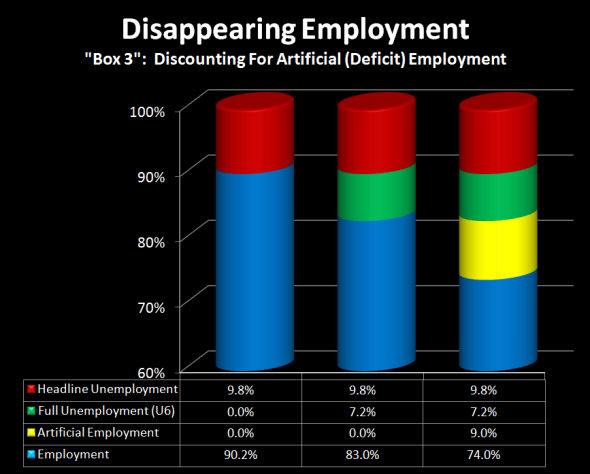
http://danielamerman.com/articles/Hiding.htm
It can be argued that the full rate of US employment is already above that seen at the height of the Great Depression. When we add in the scenario of a collapsing European economy and the resulting plunge in exports, as well as the increasingly adverse competitive environment for US workers as a result of a soaring dollar, there is a danger that US unemployment may soar to historically unprecedented levels in a very short period of time, that could be significantly worse than that seen in the 1930s.
When the Chairman of the Federal Reserve looks distressed when talking about an unemployment crisis, it is because he knows perfectly well that the crisis goes well beyond the under 10% level reported in the headlines - and he also understands just how much worse a collapse in Europe could make the situation.
Papering Over The Collapse Of Banks & Corporations
The fall of the euro may not only involve the actual default of hundreds of billions in loans to insolvent governments, but also the default-equivalent effect of trillions of euros in government and corporate loans that are paid back in suddenly cheap euros, while the US banks' liabilities are still in dollars. A new depression and plunging consumption could threaten the viability of US corporations that are heavily involved in the European market, and of the banks that lend to these companies, as well as US banks that have lent to major European corporations. Indeed the massive loan losses, particularly when multiplied by interlinked derivatives exposures and the loss of major markets could - absent any intervention by the government - be a free fall scenario that would wipe out Wall Street and many of America's largest corporations, leading them straight into bankruptcy.
Which is precisely why it won't be allowed to happen.
Before the financial crisis of 2008, I was one of the relatively few analysts who explained in advance not only how the subprime mortgage derivatives market could take down Wall Street, but could do it in a flash through creditors pulling the short term funding upon which the major firms depended. However, what to the best of my knowledge most distinguished my analysis from anyone else making this forecast, is that I was urging investors to "Invest For The Bailout, Not The Crisis".
As I wrote in a series of articles leading up to the crisis, I believed the US government would not allow a flash meltdown of Wall Street to happen but would instead attempt to bail out Wall Street, and in the process run up record levels of national debt in an attempt to contain the damage, and that the Fed would resort to outright monetization because record federal deficits wouldn't be enough by themselves.
Exactly what happened, in other words. Which was not an immediate collapse, but instead a new world of bailouts, fantastic budget deficits and the Federal Reserve creating trillions of dollars out of thin air to hand to bankers in secret deals under advantageous terms. Even as the flow of Wall Street bonuses continues.
Seeing the oncoming danger is the irreplaceable first step, however, jumping up and down and yelling that SOMETHING REALLY BAD may be about to happen is not necessarily what matters the most. If someone wants to take concrete actions to either defend what they have built, or even arbitrage the crisis, then what can be more important is anticipating the reaction, the results of the reaction, and then the reaction to that.
The danger from the Euro and European economy crisis dwarfs the danger from the US subprime crisis; it is an entirely different level of magnitude. Because of the extraordinary damage that would otherwise result - that being an immediate meltdown of the US economy - I think we can anticipate another massive bailout. Indeed, the internal US bailout that would be deployed would likely put the last three years to shame in terms of its total size.
There will be fantastic levels of not just bailouts, but likely stimulus as well. Jobs will be collapsing and state and local government finances will be collapsing - and all this may be happening within a year or less of an upcoming presidential election. The temptation will likely be politically irresistible to create money on a wholesale basis and shovel it out into the US economy, to try to get jobs going and keep corporations from collapsing.
What makes this still more likely is that this massive monetization will serve the purpose of trying to keep a lid on the value of the US dollar and give US workers some real relief in what matters most, which is global competitiveness. The more irresponsible the actions of the US government when it comes to wholesale bailout, stimulus and monetary creation, the less valuable the US dollar becomes relative to other currencies around the world, and the more employable US workers will be in fundamental terms. Over the long term this may very well work, but in the short term, the global flight to safety will likely overwhelm irresponsible US monetary actions, and keep the dollar soaring anyway.
Possible "Indian Summer" For The US Consumer
"Indian Summer" can be one of the very best times of the year in North America. The first cold snap of autumn and frosts have already occurred, and summer is well behind when suddenly out of nowhere comes a last few beautiful days of summer-like weather. With bright sunshine and warm temperatures to be enjoyed – just before the sharp descent into winter proper.
There are no assurances, but there is a reasonable chance that US consumers would enjoy a beautiful "Indian Summer" in the economy - at least if they still have jobs and salaries to enjoy it with.
The economic damage to the euro zone and rest of the world will likely slash demand for oil and other commodities. At the same time, the dollar as global reserve currency could be surging in value relative to other global currencies. So oil becomes cheaper all around the world (with the possible exception of the European economies), but in the US the 1-2 combination of lower global prices and surging purchasing power for dollars could mean the lowest oil prices in many years.
The price could drop to under $50 a barrel again, or even $40 or less. Gasoline could be under $2 a gallon. Oil prices could go into free fall in the immediate aftermath of the fall of the euro, and we could once again fill the tank of a four-door sedan under $30, with perhaps even $1.75 a gallon gasoline.
As the depression deepens, other nations will be wanting to maintain employment at all costs, even it means losing money on exports. The United States could be where everyone turns, as the last best, huge, global market for the finished goods of the world's factories, a market that pays in the global reserve currency.
Energy could be cheap, stores could be flooded with inexpensive goods, and those who have jobs and stable incomes - including many retirees - could go through a brief period where their day-to-day standard of living may even rise a bit in terms of what they can afford. That certainly won't be true for the whole population, however, as unemployment levels continue to rise.
An Animated Corpse As Winter Approaches
Indeed, the US economy will be effectively an animated corpse, filled with the seeds of its own destruction.
Fundamentally the real jobs won't be there. On a real level, the US economy will be plunging, having lost most of the European market, and under assault by cheap goods from the rest of the world trying to maintain their own economies. This assault will be facilitated by the soaring strength of the US dollar. This all on top of a reeling US economy that never has left the hidden depression which it entered in 2008.
There will be massive stimulus spending, there will be massive balance sheet injections and there will be jobs – but they will be artificial jobs, likely directed for partisan political purposes, and funded by the ever growing trillions of "fake" dollars created out of the nothingness and thrown at the economy.
In this scenario, the big banks don't collapse but they do become increasingly hollow, appearing strong only on the surface, but continuing to become fatally weaker underneath. As explained in my article from the spring of 2010, "The Fed’s Hollowing Out Of US Banks", the capital base of the US banking industry already consists largely of economically artificial assets. About 10% of US bank assets consists of balances held at the Federal Reserve, which from a regulatory perspective, are the safest of all assets. In some ways US banks are safer than ever, at least on the surface. However there's nothing really there. Federal Reserve balances are economically meaningless; they are merely an uncollateralized promise to pay, made by a central bank with unlimited monetary creation capabilities. So US banks will increasingly have no exit strategy to regain their former economic strength, and the hollowing out could reach 20% or 30% of system-wide bank assets.
http://danielamerman.com/articles/Hollow.htm
As the economy grows ever more surreal with fewer and fewer real jobs, but more and more trillions of dollars created out of the nothingness, keep in mind that every one of those new "fake" dollars will be every bit as real and have every bit as much spending power as the dollars you have in your savings and investments right now, the dollars that you worked a lifetime to accumulate. The dilution will be rapid.
The Fall Of The Dollar & The Collapse Of Illusions
Ultimately the pressure will simply grow too great. The United States will be in a highly unstable and precarious position within an effectively artificial economy that is not putting out the goods needed to pay for what it consumes. There will be massive paper money creation as the US engages in currency warfare to bring down the value of the dollar even as artificially funded jobs are created all across the country. Eventually something has to give - as historically, it always eventually does.
The US will be in a thoroughly unstable situation, and from one source or another there will be a push. That push could have a domestic origin, or more likely an international origin. Either way, because the underlying fundamentals will have already collapsed, and the belief system is all that will be holding the value of the dollar up, once the fall of the US dollar gets going and the rest of the globe heads for the exits, it could be very rapid and near impossible to stop.
We could see a whipsaw in import costs if this scenario occurs. There will be a soaring cost of energy and gasoline as the dollar implodes, and we could move quickly from a $1.50 a gallon up to $8 and $10 a gallon as oil-exporting countries no longer want US dollars that are plunging in value. We could see a sudden spike in the cost of virtually all the imports that are consumed by the US, with that external supply shock inflation rapidly becoming internalized, and domestically produced goods and services soaring in price as well.
This high rate of inflation would be economically devastating, and the only way to emerge will be to stop the monetary creation and stop the stimulus spending. Which means that many tens of millions of people become unemployed as the economic damage that was done to the corporations, banks and state and local governments must finally be recognized.
There will be tens of millions of unemployed, but the very worst of the damage will be reserved for the retirees, as is routinely the case with a high rate of inflation. Indeed, as I show in my article linked below, "Bullets In The Back: How Boomers & Retirees Will Become Stimulus, Bailout & Currency War Casualties", it has always been the retirees (and not their grandchildren) who will end up paying most of the price for bailouts, stimulus packages, record federal deficits and massive monetary creation.
http://danielamerman.com/articles/Bullets.htm
When The Value Of Money Simultaneously Plunges With The Value Of Assets
It is unlikely that the future will follow the precise path described in this article. There are too many variables in play, and how all the variables interact can't be determined at this point - with the political decisions at each stage being of particular importance. Nonetheless it is highly worthwhile for investors and those who want to prepare to consider some of the interrelationships described herein.
We don't know if a collapse of the euro is on the way or not. There are strong reasons to believe that it is, but never underestimate the collective powers of the governments of the world either, given that they make all the laws, they choose which regulations will be enforced and how they will be enforced, and their central banks can create unlimited amounts of money at will.
However when preparing for a potential euro collapse – it's important to understand that the ramifications for the US are not as clear cut as many would have you believe.
That is, many commentators would have you believe that if the euro collapses, then the US economy and the dollar will also collapse immediately thereafter and we go straight into a hyperinflationary depression scenario. That could all happen, but for the reasons explored here, there are compelling reasons to believe that the particulars of the path may be different.
Consider again what happened in 2008. The banking system didn't meltdown, but instead we got fantastic government deficits and rampant monetary creation. If you had invested for a straight-up immediate collapse of the investment banks or a collapse of the US dollar, you may not have done too well - because there were record investment bank profits afterwards and record bonuses. The details of the path matter greatly, even if the ultimate destination ends up being the same.
Let's put some different labels on what was discussed herein. What we are effectively talking about is a combination of two things that I have been writing about for a very long time: monetary inflation and asset deflation. The fundamental valuations of the great majority of investment assets are likely to be falling. Worldwide depression will do that; most assets will not be worth as much as they were before, in real terms, and this is asset deflation on a fundamental, global scale.
However, in the attempt to prevent and contain the damage, there will likely be a massive amount of monetary creation. Which means far more dollars as well as other currencies are flooding the world. So it may very well be that a given stock which trades for $5 today, will have an inflation adjusted value of $1 in the future, but because of so many dollars rattling around the world, a dollar will only be worth five cents, and the stock will sell for $20. So there is simultaneous monetary inflation and asset deflation, with the monetary inflation hiding the asset deflation even as it creates false profits that will be taxed and taken away by desperate governments.
If you have not done so, I would urge you to watch or read the very brief video / article linked below, "Deadly Dow 50,000". It will show the danger that this situation poses for retirees and other long-term investors, where the real value of their assets collapse even as their nominal value grows ever higher, creating a situation that is far worse for investors than a simple asset collapse.
http://danielamerman.com/articles/DeadlyDow.htm
As I have been writing about for almost twenty years, there are some major problems with the conventional approach to long-term and retirement investing. A core problem is the implicit assumption that we more or less know the future and it is a good one. When faced with a persistent decline in investment values and a rapidly falling value for money - conventional financial planning collapses. Because without that necessary "good future" - the solutions simply aren't there, indeed, the damage can be multiplied.
In contrast, if one believes that the purpose behind long-term investing should be to build security that genuinely protects against adverse developments, then an entirely different approach to long-term investing does open up. However, this isn't some minor tweak, but rather a whole different approach, that takes much of the conventional paradigm and turns it upside down. The first step is education.
 What you have just read is an "eye-opener" about one aspect of the often hidden redistributions of wealth that go on all around us, every day.
What you have just read is an "eye-opener" about one aspect of the often hidden redistributions of wealth that go on all around us, every day.
 A personal retirement "eye-opener" linked here shows how the government's actions to reduce interest payments on the national debt can reduce retirement investment wealth accumulation by 95% over thirty years, and how the government is reducing standards of living for those already retired by almost 50%.
A personal retirement "eye-opener" linked here shows how the government's actions to reduce interest payments on the national debt can reduce retirement investment wealth accumulation by 95% over thirty years, and how the government is reducing standards of living for those already retired by almost 50%.
 An "eye-opener" tutorial of a quite different kind is linked here, and it shows how governments use inflation and the tax code to take wealth from unknowing precious metals investors, so that the higher inflation goes, and the higher precious metals prices climb - the more of the investor's net worth ends up with the government.
An "eye-opener" tutorial of a quite different kind is linked here, and it shows how governments use inflation and the tax code to take wealth from unknowing precious metals investors, so that the higher inflation goes, and the higher precious metals prices climb - the more of the investor's net worth ends up with the government.
 Another "eye-opener" tutorial is linked here, and it shows how governments can use the 1-2 combination of their control over both interest rates and inflation to take wealth from unsuspecting private savers in order to pay down massive public debts.
Another "eye-opener" tutorial is linked here, and it shows how governments can use the 1-2 combination of their control over both interest rates and inflation to take wealth from unsuspecting private savers in order to pay down massive public debts.







If you find these "eye-openers" to be interesting and useful, there is an entire free book of them available here, including many that are only in the book. The advantage to the book is that the tutorials can build on each other, so that in combination we can find ways of defending ourselves, and even learn how to position ourselves to benefit from the hidden redistributions of wealth.


